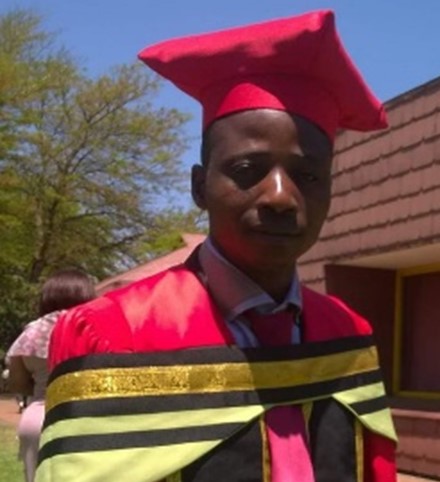-
Group Leader: Professor Thokozani Majozi

Professor Thokozani Majozi as the Dean of the Faculty of Engineering and the Built Environment.
Majozi spent 17 years in academia, of which seven have been at Wits. He is a full professor in the Wits School of Chemical and Metallurgical Engineering and also serves as the National Research Foundation/Department of Science and Innovation Chair in Sustainable Process Engineering.
His main research interest is in batch chemical process integration, where he has made significant scientific contributions that have earned him international recognition. Some of these contributions have been adopted by industry.
Prior to joining Wits, Majozi spent almost 10 years at the University of Pretoria, initially as an associate professor and later as a full professor of chemical engineering.
He also served as an associate professor in computer science at the University of Pannonia in Hungary from 2005 to 2009. He completed his PhD in Process Integration at the University of Manchester Institute of Science and Technology (UMIST) in the United Kingdom.
-
Dr. Adekomaya Oludaisi - Postdoctoral Researcher
Mathematical modelling of varying composite materials for the thermal heat transfer in cooling system: A case of refrigerated vehicle
 Mitigating heat transfer in cooling chamber is a herculean task considering the changes in ambient temperature occasioned by climate change. In a typical cooling system, like refrigerated chamber, the only known medium of reducing heat transfer is the insulated panel i.e., the use of insulation in-between the reinforcing sheet.
Mitigating heat transfer in cooling chamber is a herculean task considering the changes in ambient temperature occasioned by climate change. In a typical cooling system, like refrigerated chamber, the only known medium of reducing heat transfer is the insulated panel i.e., the use of insulation in-between the reinforcing sheet.Although, this approach has addressed substantial heat losses in some of these systems, there are still new materials which can offer low thermal conductivity and low density unlike the aluminium sheet. High density materials are synonymous to high payload while high thermal conductivity value of an external wall will require high thermal load for the cooling system due to heat infiltration through the external wall.
Having processed different materials with varying composite density and thermal conductivity using experimental approach, the involvement of mathematical modelling and integration is required to harmonise these data in order to achieve a precision in the overall material selection suitable for heat transfer.
This research project is expected to explore GAMS in the determination and validation of suitable thermal value that will be most appropriate at varying climatic weather conditions.
-
Acuman Gcabashe - MSc (Chemical) Engineering
On Optimisation of Water and Energy for Multipurpose Batch Processes with a Membrane Distillation Model
 Water and energy consumption has been a universal challenge over the past years, particularly in chemical industries. With legislations changing over the years, chemical industries have been forced to look for alternative solutions to reduce wastewater generation.
Water and energy consumption has been a universal challenge over the past years, particularly in chemical industries. With legislations changing over the years, chemical industries have been forced to look for alternative solutions to reduce wastewater generation.Over the past decades, research has focused on adopting the regeneration process to treat wastewater. Most work on wastewater minimisation for batch plants has not considered membrane distillation (MD) for the regeneration process due to the time dimension involved. MD is considered to be one of the most promising water treatment technologies with advantages of feasibility in integration with other processes and utilisation of low-grade energy.
Therefore, this research aims at developing a mathematical model that successfully integrates MD with a multipurpose batch process, which results in minimum freshwater and external utility consumption.
-
Angela Mapaya - MSc (Chemical) Engineering
A Process Systems Approach for Optimization of Energy-Water-Chemicals Nexus in Chemical Eco-Industrial Parks.
 Industrial parks are defined as industrial zones where multiple companies occupy the same land but operate independently from each other. This independent operation has resulted in industrial parks being associated with a large consumption of resources and generation of intensive pollution concentrated in one area.
Industrial parks are defined as industrial zones where multiple companies occupy the same land but operate independently from each other. This independent operation has resulted in industrial parks being associated with a large consumption of resources and generation of intensive pollution concentrated in one area.The purpose of this work is to develop a generic mathematical model that can be implemented in the grassroots design and optimization of chemicals clusters/industrial parks.
The model will identify the perfect combination of plants in the cluster and their interactions from a water-energy-chemicals nexus perspective in order to improve the overall resource efficiency of the cluster and to reduce the overall pollution potential of the cluster.
The model is superstructure based and is governed by established process integration techniques.
This work specifically focuses on the optimization of the energy-water-chemicals nexus and is expected to result in eco-industrial park designs that have minimal water, energy and chemical footprint through synergistic operation.
-
Caroline Kaitano - MSc (Chemical) Engineering
A Process Systems Analysis Towards Hydrogen Pathways Optimization

At present, South Africa uses fossil fuels for many processes to meet its energy demands which has a negative effect on the environment.
To meet these demands, whilst minimizing the negative impact on the environment and dependance on non-renewable resources, an alternative energy system is required. Hydrogen has been identified as a fit substitute.
However, achieving a fully established hydrogen economy requires well established hydrogen energy systems from better resources, and production methods. Few studies have considered possible tradeoffs between environmental sustainability, energy security, and energy equity, i.e., the energy trilemma through a comprehensive optimization model.
This research is aimed at developing a mathematical framework that will allow the synthesis and optimization of hydrogen production and yield an optimum flowsheet with the energy trilemma as the basis.
-
David Kazengura - MSc (Chemical) Engineering
A Process Systems Approach for the Optimisation of Water and Power Networks using a Continuous-Time Representation Framework

The demand for water and energy resources has been on the rise due to population increase, economic growth, and resource availability uncertainties due to climate change.
This has necessitated long-term sustainable management of these resources. Taking from the water-energy nexus (WEN) concept, the integration of water and power distribution systems is one of the ways these resources can be managed sustainably.
The problem of integrating water and power system is highly time dependent, which renders it similar to a typical large scale batch operation. Researchers have only used the discrete-time representation when solving the problem of integrating the water and power system.
The continuous-time representation has proven to produce superior results in comparison to the discrete-time representation when solving the batch process scheduling problem.
Therefore, this research aims to address the integration of water and power systems using a continuous-time representation framework.
-
Darren Morar - MSc (Chemical) Engineering
A Systematic Method for the Design and Synthesis of Continuous Ion Exchange Resins

Recent developments in the wastewater treatment industry have yielded an increase in the demand for efficient and cost-effective separation systems.
The application of ion exchange resins to treat wastewater has emerged as a potentially economical and effective process to remove ions from wastewater.
However, the ion exchange process is intrinsically complex because of its periodic nature. Consequently, this research is aimed at developing a mathematical framework for the simultaneous design, synthesis and optimization of multiple ion exchange columns operating with a continuous background process.
This framework involves optimization via a mathematical programming approach. To characterize the behaviour of the ion exchange process, dynamic models with both spatial and temporal variations are employed.
To achieve a continuous operation of the periodic process, an algebraic model for a parallel configuration of batch columns is derived, whereby the operation time of each cycle is manipulated to ensure a time-independent number of columns are permanently in the productive phase.
-
Kamogelo Tsheoga - MSc (Chemical) Engineering
A Process Systems Analysis Approach Towards the Synthesis and Optimization of a Water Network Scheme for a Multipurpose Multiproduct Textile Plant

Owing to the depleting freshwater sources and stringent environmental laws, most industries have resorted to employing process integration techniques in order to sustain their water management systems and consequently comply with environmental laws.
The textile industry being the second greatest polluter of clean water after agriculture, with an average sized textile mill consuming 1.6M litres of water per day, has had very limited research looking into the optimization of water usage.
With the demand for textile escalating in the fashion industry, freshwater consumption and wastewater are increasing proportionally thus threatening water availability as well as public health.
This research thus aims at the development of a mathematical model that will enable the synthesis and optimization of a water network scheme for textile industries in multipurpose multiproduct batch processing.
-
Nashwa El-tahhan - PhD (Chemical) Engineering
On the Development of a Mathematical Model from which the Adsorption of Cu (II) and Zn (II) from Wastewater using Water Hyacinth

Wastewater that contains heavy metal ions is considered to be a serious threat to environmental sustainability because they do not degrade into harmless end-products.
To remove heavy metals, activated charcoal has been considered an efficient adsorbent, however, it is a very expensive solution.
Therefore, an alternative adsorbent which is effective, economic and eco-friendly is required. Water hyacinth is generally considered one of the worst aquatic weeds which must be removed immediately, it gained this reputation due to its invasive potential, negative impact on aquatic ecosystem and cost needed to control it.
However, water hyacinth can be used as an adsorbent instead of collecting and destroying it. The experimental determination of the adsorption performance under various conditions is usually expensive and time consuming, so the development of a mathematical model to predict the adsorption performance is of necessity.
This study, therefore, aims at implementing a generic model that describes the adsorption of copper and zinc using water hyacinth as an adsorbent.
-
Nyasha Machakaire - MSc (Chemical) Engineering
A Superstructure Based Optimization Approach for Regeneration Reuse of Water Network: Optimal Design of a Detailed Nanofiltration Regenerator Network

Process industries use water as a utility and raw material. Global water scarcity and pollution are amongst the greatest concerns for the manufacturing sector in the 21st century.
This necessitated the employment of various strategies for reducing freshwater consumption and effluent water disposal. Water minimization is among these strategies, and much research has been done on the synthesis and optimization of water networks.
The incorporation of water regeneration into these has been found to increase the water savings, while potentially reducing the overall costs of the water networks. Nanofiltration is amongst the technologies that can be employed, but the design and optimization of nanofiltration networks for the synthesis and optimization of water networks has not yet been extensively studied, despite nanofiltration being a competitive and growing technology.
This research aims to develop a framework for the optimal design and synthesis of multi-contaminant nanofiltration membrane regenerator networks for application in water minimisation problems.
-
Phumlile Kunene - PhD (Chemical) Engineering
A Holistic Approach for Comprehensive Resource Optimisation: Focus on Chemicals, Water and Energy Nexus

The chemicals’ processing industry is beneficial to the economy. In 2017, it contributed 2.92% to the South African national GDP and 21.4% to manufacturing GDP, resulting in the improvement of livelihoods; however, it has concerning drawbacks.
This industry can be harmful to the environment due to unsustainable utilization of natural resources and being a major contributor to pollution. This has resulted in the chemical processing industry being under pressure to minimize manufacturing costs whilst ensuring that its processes are sustainable and conform to the environmental regulations.
Process integration has been used as an effective tool for achieving sustainable processes. It was initially used for optimization of energy consumption, which is best known as heat/energy integration. It was however, adopted for other resources such as water and chemical integration.
The aim of this research is to explore the chemicals, energy and water nexus using mathematical modelling techniques.
-
Vassili Revelas - MSc (Chemical) Engineering
Experimental Study of the Reaction Kinetics for the Production of Xyliton from Xylose Waste Streams

The ease of accessibility and cost of conventional sugars in modern society, especially within impoverished South African communities, has contributed to increased obesity-related diseases. Xylitol is a promising sweetener that has emerged over the past century due to its effect on carbohydrate metabolism and non-cariogenic qualities, allowing for several special dietary applications.
This research aims to develop kinetics for xylitol production by reducing xylose derived from black liquor, leading to possible commercial applications.
The reducing agent utilized in the reduction of xylose is the metal hydride sodium borohydride. This potential, cost-efficient method utilizes low temperatures and pressures, thus significantly minimizing adverse environmental and energy conditions associated with conventional methods of xylitol production.
Furthermore, this technique is applicable to pre-hydrolysis kraft pulp extracts which include other reduceable monosaccharides.
-
Vuma Ntobela - MSc (Chemical) Engineering
On Design and Optimization of an Electrolyser-Fuel Cell Hybrid System Using a Superstructure Based Approach
 Carbon dioxide levels in the atmosphere have risen higher than any point in the past 800 000 years (NOAA Climate.gov, 2021).
Carbon dioxide levels in the atmosphere have risen higher than any point in the past 800 000 years (NOAA Climate.gov, 2021).Therefore, turning to clean energy sources has become indispensable. A hybrid renewable energy generation system using hydrogen presents itself as a viable option for tackling this problem. Hydrogen is a clean, abundant and non-toxic energy storage option that is accessible from abundant sources such as water.
When extracted from saline water through electrolysis using renewable energy, such as solar or wind, it can continuously store energy for long term use, thereby addressing the intermittency problem. However, there remains a challenge in the efficiency and economic viability for setting up this process.
The aim of this research is to develop a mathematical model for synthesis, design and optimization of a hybrid system comprising an electrolyser and fuel cell.
The mathematical model will be premised on a superstructure that entails all possible process combinations, and state-of-the-art solvers will be used to find the optimum design under a predefined set of demand patterns.
-
Yannick Iluga - PhD (Chemical) Engineering
On Accelerated Methods for the Synthesis and Design of Integrated Water Systems with Multiple Contaminants

There is a growing mismatch between process demands and natural freshwater availability. Moreover, the compliance with regulations in terms of freshwater consumption and wastewater generation remain pertinent issues in the process industries.
Integrated water process synthesis is powerful in addressing the problem however, the computational requirements for the synthesis and design of robust integrated water systems with multiple contaminants remains excessively large. One of the foremost difficulties in such problems is finding a feasible starting point for the non-convex optimization problem.
To deal with the optimal design and retrofit of integrated water systems with multiple contaminants comprising detailed process model representations, this research aims at the development of an algorithmic approach that aims to exploit the problem structure to moderate the computational requirements of the optimization problem.
The proposed approach is based on the decomposition of the original problem into two interrelated primal subproblems which are iteratively solved with subsequent projection of boundary variables between the subproblems.
The algorithm allows for an accelerated search for a feasible solution from which the global optimal solution of integrated water systems can be readily found.

